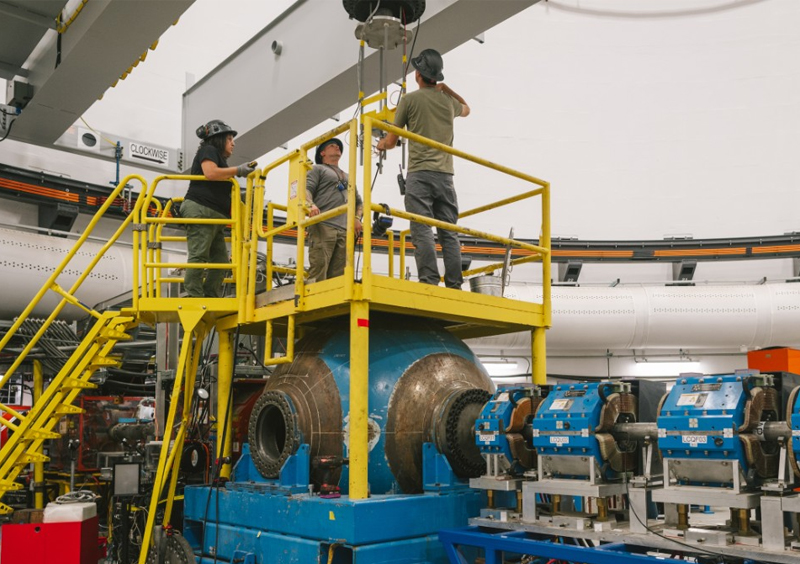A breakthrough in colloidal quantum dot technology is set to revive the field of liquid lasers, with promising applications in optofluidics, lab-on-a-chip devices, and high-contrast sensing and imaging. As described in Nature Materials, a Los Alamos-led research team exploited the unrivaled versatility of the optical properties of colloidal quantum dots — nanosized semiconductor crystals — to develop optical gain media that enable light amplification and spectrally tunable lasing in liquid form.
“The so-called type-(I+II) quantum dots developed by our team have unique properties that allow them to function as highly flexible, very stable optical-gain materials in liquid lasers,” said Victor Klimov, Los Alamos Nanotechnology and Advanced Spectroscopy team head and the project’s principal investigator. “Critically, through advances in controlling Auger recombination, we realized strong and long-lived optical gain, positioning the type-(I+II) quantum dots as very suitable media for a variety of photonic applications, including solid- and liquid-state lasers.”
By designing a compartmentalized quantum dot structure, a type-(I+II) heterostructure, Los Alamos scientists were able to almost completely suppress Auger recombination, a nonradiative process that competes with stimulated photon emission and therefore complicates the realization of lasing. This advance helped achieve liquid-state quantum dot lasing tunable over an unprecedently wide spectral range. The lasers also showed stable operation without the circulation system typical of traditional liquid dye lasers, potentially leading to the creation of simpler and more compact devices, easily integrated with various optical and electro-optical systems.
Making ‘laser-ready’ quantum dots
The realization of lasing with a liquid quantum dot solution is a more complex task than with a quantum dot solid. In a liquid medium, the quantum dot concentration is much lower than in the densely packed films, which slows down the stimulated emission and makes it less competitive with the nonradiative Auger process. Hence the need for a very strong suppression of Auger recombination.
To achieve this suppression, the Los Alamos researchers divided the interior of the quantum dot into a primary (“direct”) and a secondary (“indirect”) compartment. The latter extracts an electron from the primary compartment, creating an asymmetric positively charged optical gain state consisting of one negative electron and two positive holes. This state has fewer Auger decay paths compared with the two electron-hole pair state normally used in lasing, and hence exhibits slower Auger recombination.
“The creation of complex heterostructures expands our ability to control the photophysical properties of quantum dot materials,” said postdoctoral researcher Donghyo Hahm. “The implementation of long-lived optical gain using type (I+II) heterostructures makes it possible to amplify light even at low quantum dot concentrations.”
Making a liquid laser
To implement the liquid laser, the team incorporated a solution of type (I+II) quantum dots into a Littrow-type optical cavity, often used in traditional molecular dye-based liquid lasers. This cavity contains a diffraction grating that reflects light at different angles depending on the wavelength of the light. As a result, the resonant wavelength of the optical cavity can be easily tuned by changing the angle of the grating relative to the laser axis.
With a single quantum dot sample employed in the new design, the team achieved stable lasing at a wavelength that was simultaneously tunable through the laser windows of two laser dyes, rhodamine B and rhodamine 101. By using a smaller quantum dot sample, they could shift the entire laser window toward shorter wavelengths reaching the operating wavelengths of another dye, rhodamine 6G. Importantly, the quantum dots maintained stable lasing performance without the cumbersome and inconvenient circulation system required by existing dye lasers.
“Elimination of the circulation should simplify the laser design compared to existing dye-based systems and reduce the footprint of the device,” said postdoctoral fellow Valerio Pinchetti. “This opens the door to new laser products, including compact wavelength converters — both stand-alone and integrated — with easily replaceable gain media. Elimination of the circulation also reduces safety concerns related to accidental spatter, expanding the range of applications in areas currently restricted by safety regulations.”
The team’s results highlight the potential of colloidal quantum dots as a viable alternative to traditional laser dyes and a compelling choice for applications in both traditional and emerging technologies.
Paper: “Colloidal quantum dots enable tunable liquid-state lasers.” Nature Materials. DOI: 10.1038/s41563-024-02048-y
Funding: This project was supported by Los Alamos’ Laboratory Directed Research and Development program.
LA-UR-24-32089






